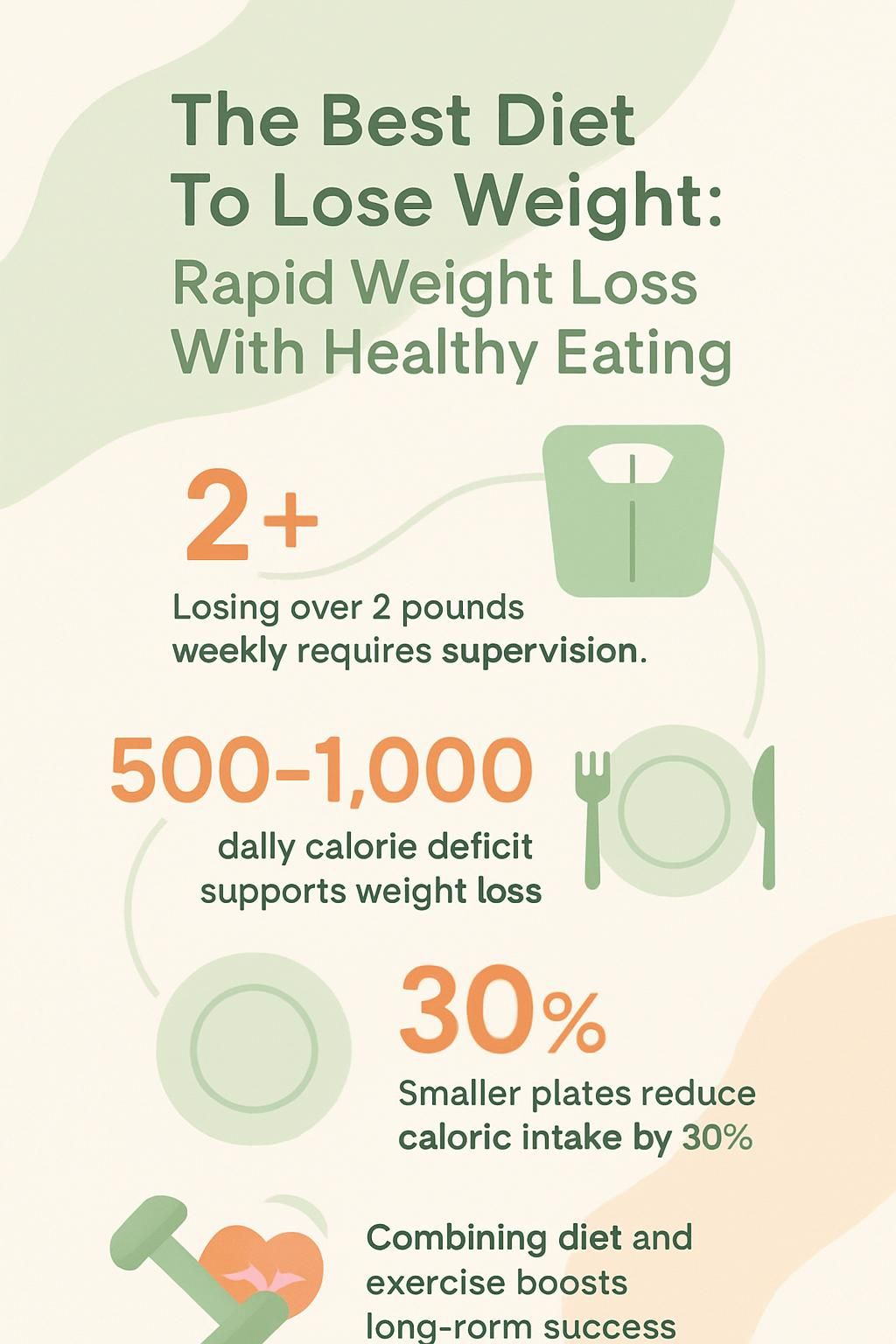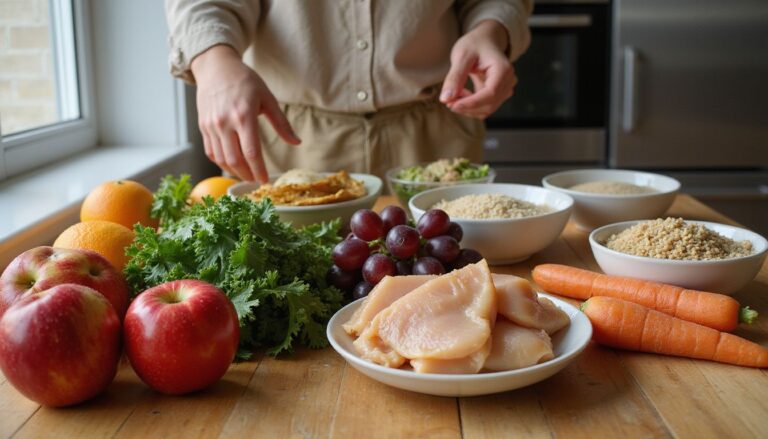The Best Diet To Lose Weight: Rapid Weight Loss With Healthy Eating
Our Nutrition Assistant AI Suite will transform your body. You will lose fat, get toned, and build muscle. Gain confidence and optimal health.
You might feel stuck trying to lose weight, especially with so much advice online. A simple plan that pairs healthy eating with a steady calorie deficit can speed progress without risking your health. This guide shows how rapid weight loss works, what a balanced diet looks like, and which foods help you move faster in a safe way.
Keep reading to build a diet strategy that fits your life and supports healthy weight loss.
Key Takeaways
- Rapid weight loss means losing over 2 pounds per week for several weeks. It can raise the risk of muscle loss and other problems, so medical guidance is wise.
- A daily calorie deficit of 500 to 1,000 calories supports a safe rate of 0.5 to 2 pounds lost each week, based on Mayo Clinic guidance.
- Fill your diet with vegetables, fruits, lean protein, whole grains, and healthy fats such as nuts or avocados. Limit processed foods, sugary drinks, refined carbs, and alcohol.
- Meal planning and smaller plates help with portion size. Research from the Cornell Food and Brand Lab shows smaller plates can cut intake by up to 30 percent.
- Pair nutrition with exercise like brisk walking, running, or HIIT. This raises calorie burn and improves long-term weight management.

Understanding Rapid Weight Loss and Healthy Eating

Rapid weight loss gets attention, yet healthy eating keeps the process safe. Knowing the difference helps you set realistic expectations and stick with changes that last.
What does rapid weight loss mean?
Rapid weight loss usually means losing more than 2 pounds, about 1 kilogram, each week for several weeks. This often comes from very low calorie plans that provide around 800 calories a day or less.
Some people can drop 3 to 5 pounds weekly on strict plans. That is faster than the common target of 1 to 2 pounds per week. These plans place stress on your body, so they are not right for everyone.
Children, teens, people who are pregnant, and many older adults should avoid these diets unless a clinician is supervising care. Losing weight too fast can change hormones and increase the chance of regain later. It can also raise the risk of gallstones and fatigue.
Why is healthy eating crucial for losing weight?
Healthy eating gives you fewer calories with more nutrients. Vegetables and fruits are low in calories and rich in fiber, so they help you feel full on less food. The Academy of Nutrition and Dietetics suggests at least five servings of fruits and vegetables per day.
Balanced meals protect muscle and keep metabolism steady as weight drops. Fad diets may create fast changes, but many people regain pounds because the plans are hard to maintain or lack key nutrients. A small, real-world tweak can go far, such as swapping a large dinner plate for a smaller one and measuring cooking oils.
Creating a Calorie Deficit
A calorie deficit means you burn more energy than you eat. This gap nudges your body to use stored fat for fuel.
Why is a calorie deficit important for weight loss?
To lose weight, you need fewer calories than your body uses. Experts at Mayo Clinic suggest a daily deficit of 500 to 1,000 calories to lose about 0.5 to 2 pounds per week. That pace supports fat loss and helps preserve muscle.
Tracking what you eat helps you avoid accidental overeating. Many women do well at 1,200 to 1,500 calories a day, while many men do well at 1,500 to 1,800 calories a day, if supervised by a clinician. Intermittent fasting can also help some people stay within a daily limit without feeling deprived.
How do you calculate your daily calorie needs?
Start with a grounded estimate. This keeps your deficit safe and your energy stable.
- Estimate your Basal Metabolic Rate, or BMR. One common method is the Mifflin-St Jeor equation:
For men: BMR = (10 × weight in kg) + (6.25 × height in cm) − (5 × age) + 5
For women: BMR = (10 × weight in kg) + (6.25 × height in cm) − (5 × age) − 161.
- Multiply BMR by your activity factor to get Total Daily Energy Expenditure, or TDEE. Use 1.2 for sedentary, 1.375 for light, 1.55 for moderate, up to 1.9 for very active.
- Subtract 500 to 1,000 calories from your TDEE to set a safe deficit.
- As a broad guardrail, NHS guidance often targets about 1,400 calories for many women and about 1,900 for many men.
- Use an app to track calories and activity so your plan stays on target.
- Adjust for pregnancy, medical conditions such as diabetes or kidney disease, or high training loads.
- Very low calorie diets near 800 calories require medical supervision due to higher risk.
- Write down a daily goal. Clear targets improve follow-through.
- Recheck your numbers each month. As weight drops, your needs change.
- Watch for warning signs like dizziness or deep fatigue, which can mean calories are too low.
- Center meals on nutrient-dense foods like beans, leafy greens, fruits, whole grains, lean protein, nuts, and seeds.
These steps help you handle weight loss with care. If you have health concerns, talk with your healthcare professional before making big changes.
Key Components of a Healthy Diet for Weight Loss
A strong plan features the right mix of protein, carbs, and fats. Good choices can also lower the risk of heart disease and some cancers.
What is the ideal balance of protein, carbs, and fats?
Use the plate method as a simple rule. Fill half your plate with non-starchy vegetables. Add a quarter lean protein such as beans, eggs, fish, or chicken. Use the final quarter for whole grains such as brown rice or whole wheat bread.
Protein reduces hunger and helps protect muscle. Include two servings of fish each week, including one serving of oily fish like salmon for heart health. Keep starches such as white rice and pasta to a third of the plate or less, and pick whole grain options most of the time. Add small amounts of healthy fats from olive or sunflower oil, nuts, or avocado.
Which nutrient-dense foods should you prioritize?
Food quality matters as much as macronutrient balance. Choose items that pack vitamins, minerals, and fiber into each calorie.
- Fill half your plate with leafy greens or cruciferous vegetables like broccoli and kale.
- Include lean protein at every meal, for example chicken, fish, eggs, beans, or lentils.
- Choose whole grains, such as oats, quinoa, barley, or brown rice.
- Pick fiber-rich fruits like berries or apples to reach five servings of produce daily.
- Use healthy fats from unsalted nuts, seeds, olives, and avocados; cook with small amounts of olive or sunflower oil.
- Eat fish twice weekly, with one serving of oily fish for omega-3 fats.
- Select lower-fat dairy like low-fat milk or plain Greek yogurt to meet calcium needs with fewer calories.
A simple example helps: build a bowl with quinoa, mixed greens, grilled salmon, cherry tomatoes, and a drizzle of olive oil. It is satisfying, colorful, and calorie aware.
Dietary Strategies for Rapid Weight Loss
Different diet structures can work. Your best choice is the one you can follow safely and consistently.
What is a Very Low-Calorie Diet (VLCD)?
A very low calorie diet usually provides 800 calories per day or less. Many plans use shakes, soups, or bars in place of regular meals. VLCDs can help adults with obesity lose weight quickly before surgery or under close medical care.
People can lose 3 to 5 pounds per week with this method. Risks include gallstones, gout, constipation, diarrhea, nausea, and fatigue. Teens, people who are pregnant, and many older adults should avoid VLCDs unless a doctor directs and monitors care.
How does a Low-Calorie Diet (LCD) work?
A low calorie diet usually targets 1,200 to 1,500 calories per day for many women, and 1,500 to 1,800 for many men. Plans often blend regular food such as lean protein and vegetables with some meal replacements.
LCDs tend to support steady loss and better muscle preservation compared with stricter plans. Many healthcare teams favor this route for long-term change. Calorie targets should reflect age, medical needs, and activity level.
What are the benefits of Intermittent Fasting?
Intermittent fasting pairs normal eating periods with set fasting windows. One example is the 5:2 plan, where you eat normally five days a week and eat very little on two non-consecutive days.
Research suggests this approach can support weight loss and may improve blood sugar, cholesterol, and blood pressure for some people. Schedules can be hard to maintain, especially with family meals or social events. Long-term results are still being studied.
How does Time-Restricted Eating support weight loss?
Time-restricted eating limits eating to a daily window, such as 16 hours fasting and 8 hours eating. Shorter eating hours often reduce total calories and trim sugary drinks and snacks.
This approach is flexible, since you can choose foods you enjoy during the eating window. Early studies show promise for overweight adults. If you have diabetes or take medications that affect blood sugar, get medical advice before starting.
Foods to Include in a Weight Loss Diet
Picking the right foods makes it easier to lose weight and maintain your progress.
Why are leafy greens and cruciferous vegetables good for weight loss?
Leafy greens and cruciferous vegetables are low in calories and high in fiber. They help you feel full without adding many calories. Fill half your plate with spinach, kale, broccoli, cauliflower, or similar options.
Aim for at least five servings of produce a day. These choices deliver vitamins and minerals while supporting a calorie deficit. They work in both Mediterranean-style and lower carb plans.
How do lean proteins like chicken and fish help?
Lean proteins keep you satisfied and support your muscles. Start your day with protein so hunger stays in check. Plan for protein to take about a quarter of your plate at meals.
Try chicken breast, turkey, eggs, fish, beans, or tofu. Aim for two servings of fish weekly, including an oily option such as salmon or sardines. Many people notice fewer cravings when protein is steady at each meal.
What role do whole grains and legumes play?
Whole grains like oats, brown rice, and whole wheat bread provide fiber and steady energy. Keep carb foods to about a third of your plate. Pick whole grains more often than refined grains.
Legumes such as beans, lentils, and chickpeas deliver plant protein plus extra fiber. They improve fullness and help control blood sugar. Regular intake supports an eating plan that is both filling and calorie smart.
Why include healthy fats such as avocados and nuts?
Healthy fats help with satisfaction and nutrient absorption. Avocados, nuts, seeds, and olive oil provide unsaturated fats that support heart health. You also absorb fat-soluble vitamins A, D, E, and K better when meals include some fat.
Use small amounts to manage calories. Swapping a sugary snack for a handful of almonds can steady your energy and reduce grazing later.
How do fiber-rich fruits aid weight loss?
Fruits with fiber, like apples, pears, and berries, help you feel full on fewer calories. They also slow the rise of blood sugar, which helps control hunger later.
Choose fruit instead of chips or candy. A simple swap such as sliced banana at breakfast or an apple in the afternoon can cut dozens of calories and add helpful fiber.
Foods to Avoid or Limit
Some foods add many calories fast without helping you feel full. Limiting them makes a calorie deficit easier to maintain.
Which processed foods and sugary snacks should you avoid?
Skip packaged cookies, chips, pastries, candy bars, and similar snacks. They combine added sugar, refined flour, and unhealthy fats. That mix can drive overeating and weight gain.
Frozen pizzas, instant noodles, sugary cereals, and soda also pack many empty calories. Diets high in these foods are tied to weight regain after dieting in several reviews. Choose whole foods more often to support steady progress.
Why limit sugary beverages and alcohol?
Sugary drinks add large amounts of calories without filling you up. A 12-ounce soda has about 150 calories and around 39 grams of sugar. These drinks spike blood sugar, which can trigger hunger soon after.
Alcohol adds calories and can slow fat burning. A beer has about 150 calories. Many cocktails contain far more due to mixers and syrups. Cutting back on alcohol and sugar-sweetened drinks often improves energy and weight loss results.
What are refined carbohydrates and why avoid them?
Refined carbs are foods like white bread, regular pasta, and many pastries. Processing strips out fiber and some nutrients. That can lead to quick spikes and crashes in blood sugar, followed by hunger.
Keep starchy foods to a third of the plate or less. Choose whole grain versions most of the time. Replacing refined carbs with whole grains supports fullness and steadier energy.
Portion Control and Meal Planning
Portion control and planning set your days up for success, even during busy weeks.
How can you measure portion sizes effectively?
Use smaller plates and bowls to serve less food with the same visual impact. Research from the Cornell Food and Brand Lab shows a 10-inch plate can reduce intake compared with a 12-inch plate.
Measure fats like oil or butter with teaspoons to control extra calories. Weigh proteins and carbs when you can. Avoid second helpings, and add two vegetable servings at main meals to boost volume without many calories.
What are tips for preparing balanced meals?
A little prep reduces stress and keeps your meals balanced. Start simple, then repeat what works.
- Use the plate method: half non-starchy vegetables, one quarter lean protein, one quarter whole grains.
- Mix colorful produce, legumes, nuts, seeds, and whole grains into your week.
- Serve at least two vegetable servings at lunch and dinner to raise fiber and fullness.
- Choose lower-fat dairy like skim milk or plain Greek yogurt.
- Add healthy fats in small amounts such as avocado, nuts, or olive oil.
- Rotate proteins, including poultry, fish, beans, tofu, and eggs.
- Portion with smaller plates or a kitchen scale.
- Keep a list of go-to healthy recipes for busy nights.
- Drink water before meals to help manage appetite.
- Include all major food groups across the week for steady nutrition.
The Role of Hydration in Weight Loss
Hydration is like a quiet helper. It supports appetite control and metabolism without adding calories.
How does drinking water benefit weight loss?
Drinking water before meals can reduce how much you eat. It supports digestion and helps your body absorb nutrients from food. Replacing soda or juice with water trims daily calories and makes a deficit easier to reach.
For instance, swapping one 12-ounce soda for water can save about 140 calories a day. Over three weeks, that can equal about a pound of body fat, even without other changes.
How much water should you drink daily?
Aim for about 6 to 8 cups of fluids daily. This includes water, tea, coffee, and broth-based soups. You may need more if you exercise in heat or sweat a lot.
Choose water or low-calorie drinks most of the time. Setting phone reminders or using a water bottle with marks can help you stay on track.
The Role of Exercise in Rapid Weight Loss
Healthy eating drives results, and exercise acts like a booster for calorie burn and confidence.
How does combining diet and exercise enhance weight loss?
Pairing nutrition changes with activity creates a larger calorie deficit. Exercise helps maintain muscle while you lose fat. It also supports heart health and blood sugar control.
People who track both food and activity often do better than those who track only one. A simple activity goal each day can lift motivation and reduce weight regain.
What exercises best support rapid weight loss?
Choose activities you enjoy so you can stay consistent. Mix cardio and strength for the best results.
- Brisk walking burns about 280 to 370 calories per hour for many adults.
- Running can burn 600 calories or more per hour, depending on pace and body size.
- Resistance training builds muscle, which raises resting metabolism.
- High-intensity interval training, or HIIT, alternates sprints and rest for high calorie burn in less time.
- Group classes like cycling or dance add structure and social support.
- Swimming works the whole body with less joint stress.
- Blend cardio days with strength days to keep progress steady and reduce injury risk.
If you have medical conditions or you are new to exercise, ask your clinician for guidance before starting a new program.
Potential Health Concerns of Rapid Weight Loss
Fast results can carry trade-offs. Knowing the risks helps you protect your health.
What are the risks of extreme calorie restriction?
Eating too few calories can increase the risk of gallstones, gout, fatigue, constipation, diarrhea, and nausea. Staying near 800 calories a day for more than 12 weeks raises these risks.
Very low intake can also lead to nutrient gaps. That can weaken your immune system and lower energy. Rapid plans often end with quick regain once you stop. Children, teens, people who are pregnant, and many older adults should avoid extreme plans unless a medical team supervises care.
How can you recognize unhealthy weight loss signs?
Warning signs include constant fatigue, dizziness, ongoing digestive issues, or frequent nausea. Rapid regain after a strict plan can signal an approach that was too extreme.
If you are hungry all the time or feel deprived, your plan may lack vital nutrients or calories. Speak with a healthcare professional if symptoms appear or if you are unsure about safety.
Maintaining Long-Term Results
Short-term wins feel great. Turning them into habits helps you keep the weight off.
How do you transition to a sustainable eating plan?
Shift from strict rules to routines you can live with. That makes weight maintenance more realistic.
- Add one new healthy food from each major food group each week to build variety.
- Pick foods you enjoy so you can stick with the plan longer.
- Use the plate method to keep portions in check at most meals.
- Weigh yourself weekly and adjust if trends creep upward.
- Track food and activity with an app or a simple journal.
- Allow a small treat once a week to reduce cravings and prevent binges.
- Move back to regular, balanced meals if you used a strict diet for a short time.
- Batch-cook grains, roast vegetables, or prep proteins on weekends to save time.
Many people find that keeping enjoyable meals and planned treats helps prevent rebound eating and supports steady habits.
What healthy habits support lifelong weight management?
Daily practices keep progress going and reduce decision fatigue.
- Set small weekly goals and monitor your progress.
- Eat at least five servings of fruits and vegetables each day.
- Choose nutrient-dense foods like whole grains, lean protein, and healthy fats.
- Limit processed snacks, refined carbs, sugary drinks, and alcohol.
- Drink 6 to 8 cups of fluids daily, mostly water or low-calorie choices.
- Build regular physical activity into your routine, such as walking or biking.
- Use social support from family, friends, or online communities.
- Prep meals in advance and measure portions to avoid mindless eating.
- Keep a log of meals and snacks to spot patterns and make small fixes.
Consulting a Healthcare Professional
Personal health conditions change what is safe and what works best. Expert guidance can tailor your plan to your needs.
Why is personalized dietary advice important?
Conditions like diabetes or thyroid issues, along with medications, can affect hunger and metabolism. A registered dietitian or clinician can adjust targets so your plan stays safe and effective.
Food culture, allergies, budget, and schedule all matter. Evidence shows individualized plans often lead to better weight loss than generic advice.
When should you seek professional guidance?
If you have diabetes, heart disease, thyroid disorders, or you are pregnant, talk with a healthcare professional before starting a new plan. Teens and many older adults also benefit from a medical review.
If you notice dizziness, fainting, hair loss, or other concerning symptoms, get help. Medical support protects your health while you work on weight management.
Frequently Asked Questions
Here are clear answers to common questions about diet and weight loss.
What is the best diet for weight loss?
The best diet is one you can follow long term. Balanced plans like DASH, Mediterranean, Mayo Clinic, or WeightWatchers emphasize non-starchy vegetables, lean protein, and whole grains. The plate method is a simple template that fits most kitchens.
Gradual changes tend to last longer than crash plans. Build meals from nutrient-dense foods and allow small treats. If you need help, ask a healthcare professional to tailor an eating plan for you.
Can you lose weight without exercise?
Yes. Weight loss depends on a calorie deficit. Many people lose weight through food changes alone. That said, exercise improves health, preserves muscle, and helps maintain weight loss over time.
If activity is not possible right now, focus on consistent portions and calorie tracking. Gentle walks or short movement breaks can be a helpful start.
How quickly can you safely lose weight?
Most experts recommend 0.5 to 2 pounds per week. Faster loss can increase risks, including muscle loss and gallstones. Very low calorie diets should be supervised by a clinician.
Crash plans may create fast changes, but regain often follows. Slow and steady habits are easier to maintain.
Success Tips for Weight Loss
Clear goals and simple systems help you stay on track during busy weeks.
How do you set realistic weight loss goals?
Aim to lose 0.5 to 2 pounds per week. Set specific, trackable targets, such as a daily calorie range or three strength sessions per week. Free tools like the NHS Weight Loss Plan can help with structure.
Log weekly weigh-ins and adjust if your results stall. Small, steady progress adds up and builds confidence.
What strategies help you stay consistent and motivated?
Consistency beats perfection. Use tools and support that fit your life.
- Track food and activity daily with an app or journal.
- Set small goals, such as 8,000 steps a day or packing lunch five days a week.
- Join a group or an online program for accountability.
- Plan an occasional treat to prevent feelings of deprivation.
- Use meal planning tools and calorie calculators to reduce guesswork.
- Celebrate wins beyond the scale, like better sleep or more energy.
- Review your log each week and make one small change at a time.
Conclusion
The best way to lose weight is a plan you can live with. Focus on healthy eating, a consistent calorie deficit, and portion control. Add regular physical activity for extra momentum and better weight management.
This article is for general education. Talk with your healthcare professional before starting a low-calorie or rapid weight loss plan, especially if you have medical conditions or take prescriptions. Small, steady choices today can support faster progress now and better health for years to come.
FAQs
1. What is the best diet for rapid weight loss with healthy eating?
A balanced meal plan that focuses on whole foods, lean proteins like chicken or fish, vegetables, fruits, and whole grains supports fast yet safe fat reduction. Studies show diets low in processed sugars and high in fiber help people lose pounds while keeping energy steady.
2. How many calories should I eat each day to lose weight quickly but safely?
Most adults need a daily calorie deficit of 500 to 750 calories from their maintenance level for steady fat loss. For example, if your body needs 2,000 calories to maintain your current size, aim for about 1,250 to 1,500 calories per day; always consult a registered dietitian before making changes.
3. Which foods should I avoid when trying to lose weight rapidly through healthy eating?
Limit sugary drinks such as soda or juice cocktails; skip fried snacks and baked goods made with white flour; reduce intake of fatty meats like sausage or bacon; avoid packaged meals high in sodium and preservatives.
4. Can personal experience support evidence-based advice on losing weight with healthy eating?
Yes; research confirms that tracking food choices helps people stay accountable during their journey toward better health. For instance, using a simple journal helped me notice patterns between my vegetable intake and how full I felt after meals.
Summary: Choosing nutrient-rich options such as lean poultry or seafood along with fresh produce can speed up results without sacrificing nutrition. Reducing empty-calorie items makes it easier to reach goals based on scientific guidelines while real-life habits reinforce lasting change.







